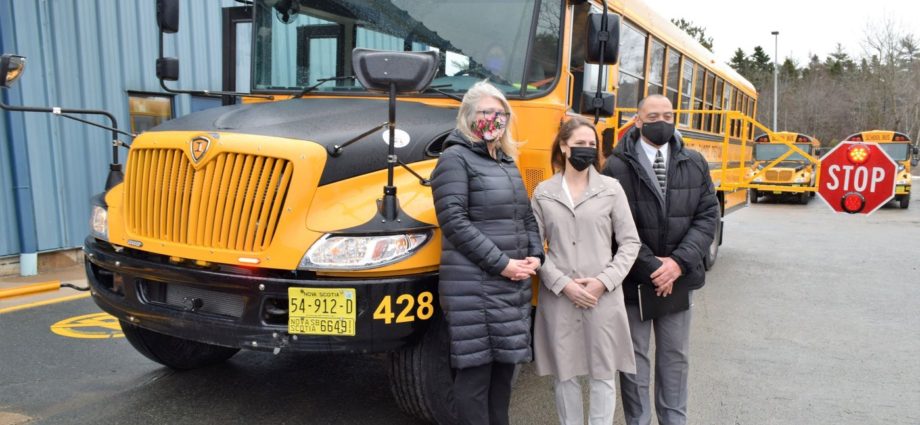
By Kevin McBain, Local Journalism Initiative Reporter, LighthouseNOW Progress Bulletin
March 30, 2022
A new, stronger message is being sent out to those who pass a school bus when it’s stopped and its lights are flashing.
The South Shore Regional Centre for Education (SSRCE) is testing an Extended Stop Arm (ESA) on a bus on Route 245 in the Hebbville area. The arm extends from the school bus by two metres and into the other oncoming lane. It boasts two stop signs with flashers.
The SSRCE will monitor the results of the pilot project until at least to the end of the school year, after which it will consider installing ESAs on other bus routes.
The SSRCE, which oversees schools in Queens and Lunenburg counties, announced the pilot ESA project March 21 at its bus garage in Bridgewater.
“We think it will be highly visible to anyone coming up on our school bus,” said Denise Covey, transportation coordinator for the SSRCE. “We hope it makes the bus more visible, and really at the end of the day we want to increase student safety, and we feel this is a product that will help us do that.”
The ESA trial is a first for Nova Scotia and only the third in Canada. The other two school areas trying the extended arm are in British Columbia. Covey indicated she hasn’t yet received any specific data on the ESA trials in B.C., nonetheless she reported there was a “huge decrease” in violations.
Currently, all school buses are equipped with flashing lights, a curved arm in the front of the bus to protect the riders, and a shorter arm with a single stop sign that comes out each time the bus stops to allow a student to get on or off. Many of the buses in the SSRCE catchment area also are equipped with cameras that may photograph offenders who pass the stopped bus along with their vehicle licence plates, such as the bus on Route 245.
Despite these safety initiatives, there were 178 red-light violations recorded in the 2020-21 school year. Route 245 was chosen as a testing ground because it has the highest rate of red-light violations in the SSRCE with 12 violations. On any given school day, SSREC has 87 buses on the road in Queens and Lunenburg counties.
The test arm was purchased from a company in Winnipeg at a cost $5,500, with the funds coming from the SSRCE’s operations budget. Installation was by the local bus garage technicians.
Becky Druhan, Nova’s Scotia’s minister of education and early childhood development, was on hand for the unveiling.
“For many students, their day starts on a school bus and ends on a school bus, and it’s important to ensure they have a safe commute. I applaud the team at SSRCE for their initiative in launching this pilot,” she said, adding that she was surprised at the number of violations that took place on the route.
“I appreciate their ingenuity and I look forward to learning about the results of these efforts. Thank you as well for providing a reminder to motorists and cyclists about respecting the traffic laws around school buses. We all have a role to play when it comes to safety on the roads,” said Druhan.
It’s illegal to pass a school bus with its lights flashing. All motorists, both in front and behind the bus, and in all lanes of traffic must stop. In Nova Scotia, a red-light violation can result in a fine of $410 and six demerit points on the driver’s licence, notes an SSRCE news release relating to the project.
The ESA was one of four recommendations to improve school bus safety raised by a task force that was struck in January 2019 by the federal government’s council of ministers responsible for transportation and highway safety
Sign Up for Our Newsletter.
The council released its report in February 2020, which recommended the ESA option. Other recommendations were infraction cameras, exterior 360-degree cameras and automatic emergency braking.


